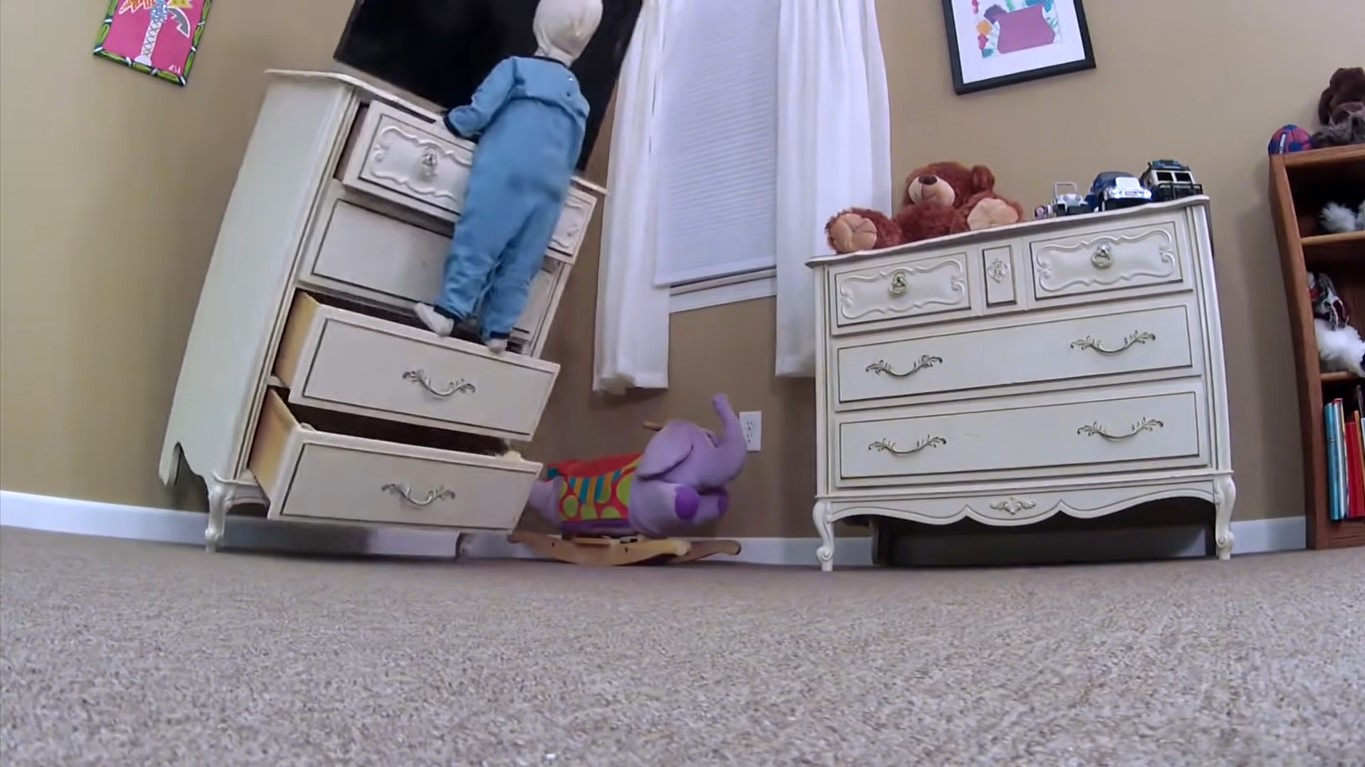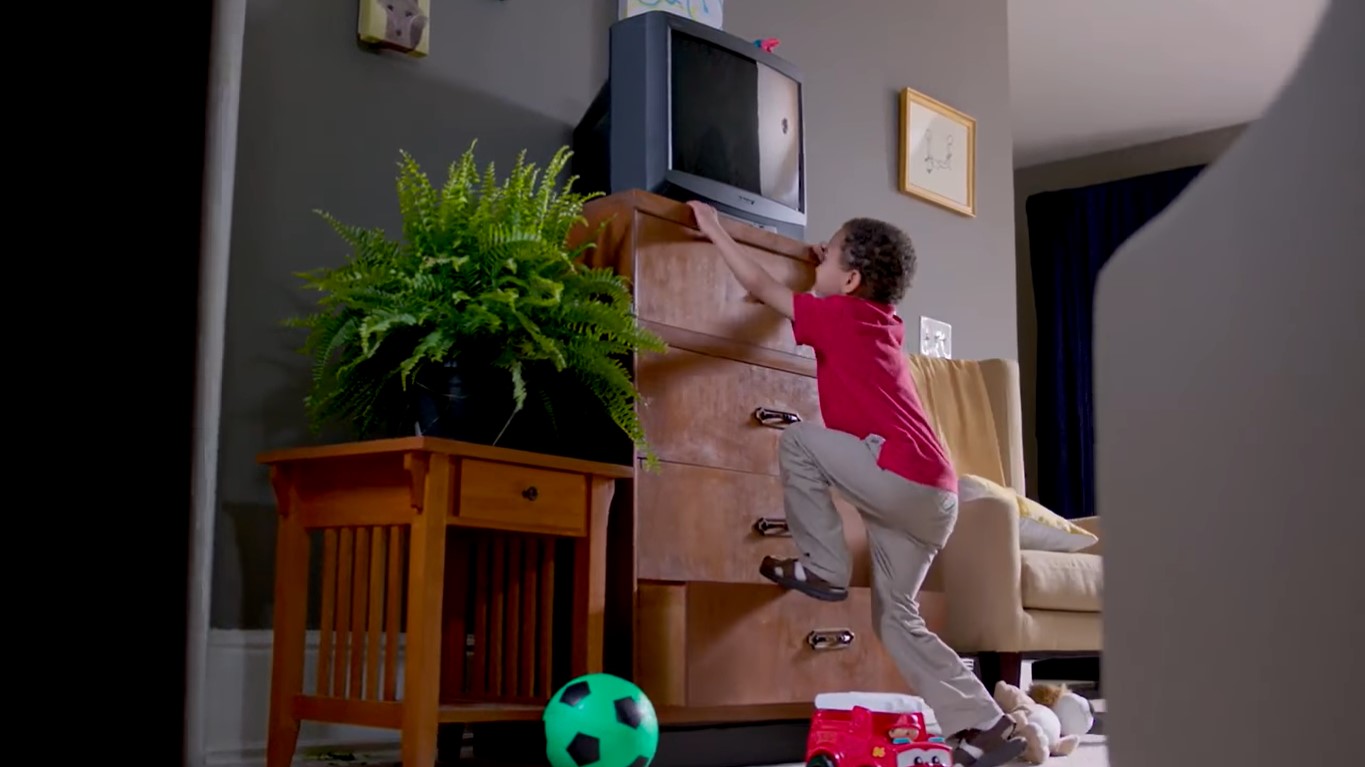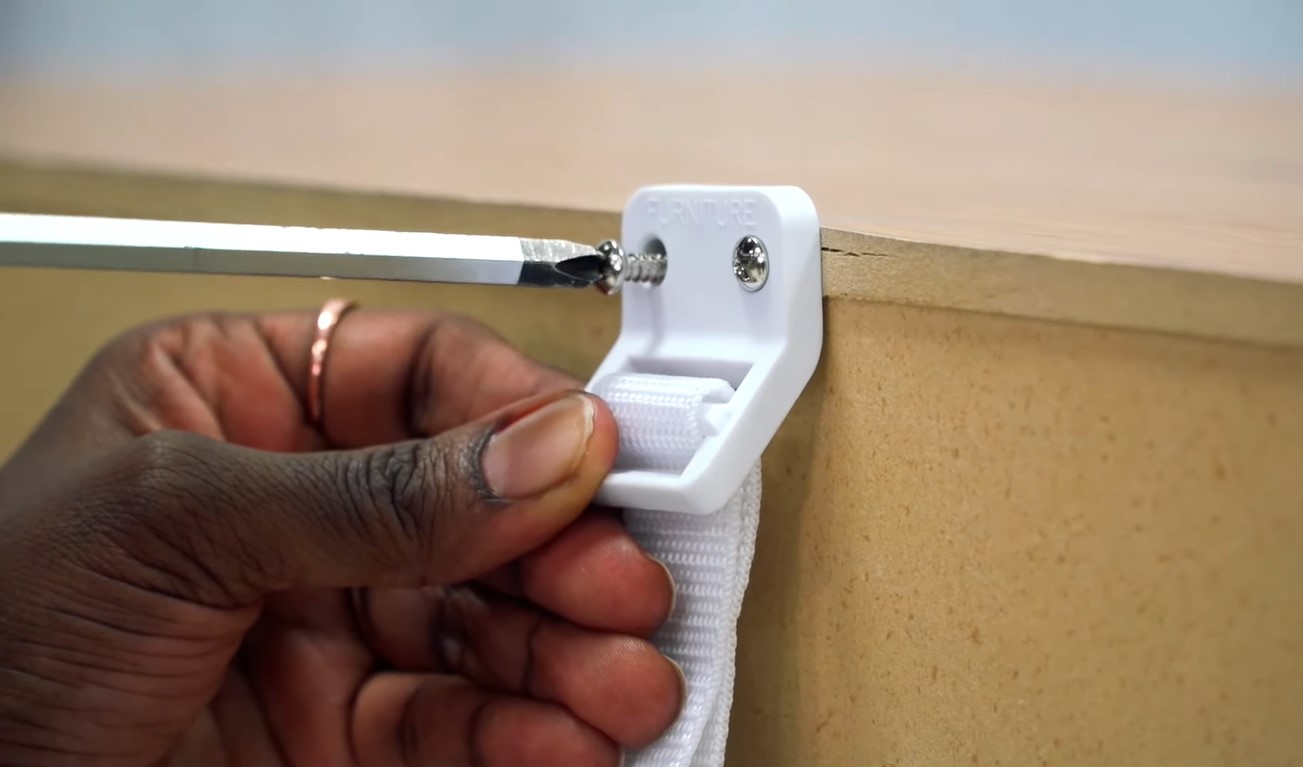Child Safety Alert - Risks Of Unsecured Furniture Falling
Keep your home safe for kids. Learn how to safeguard your children from the threat of furniture falling accidents and other tip-over incidents. Safety first!
Author:Paolo ReynaReviewer:Iram MartinsSep 12, 202316.9K Shares226K Views

Ensuring the safety of our children has become an increasingly important concern for parents and caregivers, particularly incidents concerning furniture falling.
While we childproof our homes against obvious dangers like sharp objects and electrical outlets, there is a silent yet significant threat that often goes unnoticed - unsecured furniture.
They pose a serious hazard to our little ones.
Let’s discover and understand the potential consequences of furniture falling. Learn some tips and strategies to protect our children from this often-underestimated danger.
Furniture Falling On Child
In February 2022, the U.S. Consumer Product Safety Commission (CPSC) released “Product Instability or Tip-Over Injuries and Fatalities Associated with Televisions, Furniture, and Appliances: 2021 Report.”
This CPSC 2021 reportcontains data related to emergency department (ED)-treated injuries caused by furniture falling incidents and similar tip-over accidents involving TV and other appliances.
The table below shows the average of estimated ED-treated injuries from 2011 through 2020 among children aged 17 years old and below:
| Year | ED-Treated Injuries - All Furniture* (estimates) |
| 2020 | 6,100 |
| 2019 | 8,300 |
| 2018 | 9,200 |
| 2017 | 8,800 |
| 2016 | 10,100 |
| 2015 | 9,900 |
| 2014 | 11,000 |
| 2013 | 12,200 |
| 2012 | 13,600 |
| 2011 | 13,600 |
*The term “All Furniture” refers to tip-over incidents involving appliances, furniture, and TV.
You can notice that the figures went down each year, which was a good sign; nevertheless, the numbers of incidents were still high.
Compared to the furniture falling incidents among people aged 18 to 59, those involving children were higher.
The annual average (2011-2020) of estimated ED-treated injuries injuries from tip overs involving 18-59-year-old people ranged from 5,100 to 9,300. Among children aged 17 and below, 6,100 to 13,600.
So, how often does furniture fall on kids?
Answers will vary but WCNC Charlotte reported that based on the CPSC 2021 report, a child dies every two weeks from injuries sustained from tip-over incidents.
Citing the same report, the National Public Radio (NPR) said that in the U.S., four out of five furniture falling-related deaths since 2000 involved children.
According to Nationwide Children’s Hospital, in 2019, the emergency department of hospitals in the U.S. attended to 11,521 children because of tip-over accidents.
It meant that every 46 minutes, a child got into a TV or furniture tip-over.
The most common furniture falling accidents involve children aged 10-17 years old and the following pieces of furniture:
- bookshelves
- cabinets
- desks
| Children | Injuries Sustained from Furniture Falling |
| 2-6 years old | closed head injuries; concussion |
| 10-17 years old | lower body injuries |
Children 2-6 years old (more common among two-year-olds) tend to be more prone to furniture tip-overs.
These furniture falling accidents usually happen because:
1. Children hold onto to furniture or pull it onto themselves.
2. Children push the furniture.
3. Children climb the furniture.
4. Nothing secures the furniture to prevent it from tipping over.
The CPSC launched in 2015 a campaign called Anchor It!to prevent furniture falling accidents and similar tip-over incidents.
Furniture Tip-Over Deaths
The National Council on Aging (NCOA) shared a real-life testimonial on how fatal furniture falling incidents can be.
An anonymous mother shared what happened to her 3-year-old daughter, Meghan. She recalled what she and her husband saw on the morning of December 18, 2004:
“„We found her lifeless under her dresser. It had fallen on her during the night, while the rest of our family was asleep. We didn’t hear it fall. She was unable to cry.- anonymous mother
The young victim’s mother added:
“„She died in a matter of minutes. Alone. Under a small, heavy, well-made and expensive juvenile dresser I mistakenly thought was safe.- anonymous mother
A joint report by the Paris-based Organization for Economic Co-operation and Development (OECD) and the Australian Competition and Consumer Commission (ACCC) reveals that children 9 years old and below are more likely to encounter furniture falling incidents.
That age group is also the one with the highest risk of dying from tip-over accidents.
What Is ASTM F2057?
ASTM F2057 is a standard developed by Philadelphia-based standards organization ASTM International (est. 1898), formerly known as the American Society for Testing and Materials.
This standard is titled “Standard Safety Specification for Chests, Door Chests, and Dressers.”
It specifically addresses safety requirements and test methods for these types of furniture items to reduce the risk of furniture falling accidents, particularly involving children.
The main purpose of ASTM F2057 is to establish safety requirements that aim to prevent furniture (e.g., dressers and chests of drawers) from tipping over.
Furniture falling can cause injuries or fatalities, especially when children climb on or interact with them. The standard sets out specific criteria for:
- stability
- structural integrity
- warning labels
Key elements of ASTM F2057 include:
a. Stability Requirements
The standard defines stability requirements that furniture must meet, ensuring that it can withstand a certain degree of force without tipping over.
b. Drawer and Door Strength
It outlines requirements for the strength of drawers, doors, and other moving parts of the furniture to prevent them from becoming entrapment hazards.
c. Test Methods
ASTM F2057 provides detailed test methods to evaluate the stability and safety of the furniture, including both static and dynamic tests.
d. Labeling Requirements
The standard specifies labeling requirements to inform consumers about the potential hazards and proper use of the furniture.
This includes warning labels and instructions for anchoring furniture to prevent furniture falling incidents.
ASTM F2057 is an important standard for manufacturers and consumers alike, as it helps ensure that furniture products on the market are designed and constructed with safety in mind.
When purchasing dressers, chests, or similar furniture items, consumers should look for products that comply with ASTM F2057.
Doing so will help reduce the risk of furniture falling accidents, particularly in households with young children.
The STURDY Act
In June 2016, Senator Bob Casey Jr. (District of Pennsylvania) introduced a bill to prevent child injuries and deaths attributed to furniture falling and similar tip-over incidents.
According to Sen. Casey’s website, he called the bill, the Stop Tip-overs of Unstable, Risky Dressers on Youth (STURDY) Act. The senator said:
“„This bill would help protect kids by directing the CPSC [Consumer Product Safety Commission] to establish a stronger, mandatory stability standard to prevent kids from being injured or killed by tip-overs of chests, dressers and bureaus.- Senator Robert Patrick “Bob” Casey Jr. (D-PA)
In February 2021, Sen. Richard Blumenthal (District of Connecticut) and Sen. Amy Klobuchar (District of Minnesota) joined Sen. Casey to reintroduce the bill.
Representative Jan Schakowsky (District of Illinois) likewise supported the bill. During that time, she was the chair of the Energy and Commerce Committee’s Consumer Protection and Commerce Subcommittee.
On December 23, 2022, the U.S. Congress passed the STURDY Act. It empowered the Congress to “implement mandatory furniture stabilization standards,” according to Rep. Schakowsky, as quoted by Consumer Reports.
A few days after, President Joe Biden signed H.R. 2617, otherwise known as the “Consolidated Appropriations Act, 2023,” into law on December 29, 2022. Included in it is the STURDY Act.
On April 19, 2023, according to the German service corporation TUV SUD, CPSC “voted 3 to 1 to implement the STURDY Act” and to adopt ASTM F2057-23 as the commission’s “mandatory safety standard.”
Furniture Tip-Over Prevention
Keeping your furniture from tipping over is essential for safety, especially if you have young children or live in an earthquake-prone area.
CPSC Chair Alexander Hoehn-Saric said in a 2022 NPR interview:
“„People either don’t know about the risks, or they think it can’t happen when an adult is nearby.- Alexander D. Hoehn-Saric
Hoehn-Saric added that furniture anchors are easy to install (approximately 20 minutes or less) and mostly affordable (less than $20).
Here are some tips to help you prevent furniture falling incidents:
1. Secure Heavy Items to the Wall
Use anti-tip straps or brackets to secure heavy furniture like bookcases, dressers, and shelving units to the wall. These are readily available at hardware stores and are easy to install.
2. Distribute Weight Evenly
Ensure that heavy items are placed on lower shelves or drawers of furniture to lower the center of gravity, making it less likely to tip over.
3. Use Furniture Anchors
Consider using furniture anchors for items that can’t be secured to the wall, such as:
- televisions
- audio equipment
- other electronics
These anchors attach the furniture to the wall, preventing tipping.
Now if you have a television on a stand, make sure the stand is stable and secure. Consider anchoring the stand to the wall or using anti-tip straps for added safety.
4. Avoid Overloading Shelves and Drawers
Don’t overload shelves or drawers with too much weight. Keep heavy items on the lower shelves or drawers and distribute the weight evenly.
5. Place Heavier Items at the Bottom
In bookcases or cabinets, put heavier items at the bottom and lighter ones at the top to maintain stability.
6. Check for Unstable Furniture Design
Some furniture designs are inherently unstable, like tall and narrow bookshelves. Be cautious with such designs or secure them to the wall.
7. Use Levelers
Ensure that furniture legs are properly adjusted and use levelers to stabilize furniture on uneven surfaces.
8. Keep Cords Tidy
Avoid letting cords from electronics hang down or dangle, as they can create a tripping hazard and potentially pull on the furniture.
9. Teach Children about Furniture Safety
Educate children about the dangers of climbing on furniture and make it clear that it’s not a safe or acceptable behavior.
10. Regular Maintenance
Periodically check and tighten any screws, bolts, or fasteners on your furniture to ensure that it remains stable.
11. Consider Earthquake Straps
If you live in an earthquake-prone area, consider earthquake straps specifically designed to secure furniture during seismic activity.
12. Be Mindful of Placement
Avoid placing heavy items on top of furniture that can become top-heavy, such as dressers or cabinets. Keep these surfaces clear of heavy objects.
People Also Ask
What Are The Safety Considerations While Selecting Furniture For Children?
When selecting furniture for children, safety should be a top priority. Children are naturally curious and may not always be aware of potential dangers.
Here are some important safety considerations to keep in mind when choosing furniture for children:
a. Stability
- Ensure that the furniture is stable and unlikely to tip over. Look for items with a wide base or the option to anchor them to the wall.
- Avoid lightweight furniture that can easily be knocked over by a child’s weight or movements.
b. Materials
- Choose furniture made from non-toxic and child-friendly materials. Avoid furniture that contains harmful chemicals like lead, phthalates, or formaldehyde.
- Check for safety certifications, such as the Consumer Product Safety Commission (CPSC) label in the United States.
c. Edges and Corners
- Opt for furniture with rounded or cushioned edges to prevent injuries from sharp corners.
- If the furniture has sharp corners, consider using corner protectors to cover them.
d. Paints and Finishes
- Ensure that any painted or finished surfaces are free from lead-based paint and other toxic substances.
- Look for furniture that has been finished with child-safe, non-toxic paints or stains.
e. Small Parts
- Be cautious of furniture with small removable parts, like knobs or handles, which could pose a choking hazard for young children.
- Check that any drawers or doors are securely attached.
f. Height and Accessibility
- Make sure that the furniture is of an appropriate height for the child’s age and size. It should be easy for them to reach and use without climbing.
- Use step stools or child-sized furniture to make items more accessible when needed.
g. Drawer and Cabinet Latches
- Install safety latches on drawers and cabinets.
- They will keep children from accessing potentially dangerous items or getting their fingers caught.
h. Bunk Bed Safety
- If using bunk beds, ensure they meet safety standards, have guardrails on both sides, and the top bunk has safety rails.
- Only allow older children who can safely navigate a bunk bed to sleep on the top bunk.
i. Mattress Fit
- Ensure that mattresses fit snugly in cribs or beds without gaps that could entrap a child.
- Use a firm mattress designed for the specific crib or bed.
j. Fire Safety
- Consider the fire resistance of the furniture's materials, especially in children’s bedrooms.
- Keep furniture away from heat sources, electrical outlets, and flammable materials.
k. Cord Safety
- Keep cords from blinds, curtains, and electronics out of reach to prevent strangulation hazards.
- Consider cordless window treatments in children’s rooms.
l. Regular Inspections
- Regularly inspect and maintain the furniture to ensure it remains safe over time.
- Check for loose parts, damaged surfaces, or any potential hazards.
m. Age-Appropriate Toys and Decorations
- Buy them because they’re designed with a child’s developmental stage and safety in mind.
- They also reduce choking hazards and accidents.
What Are 5 Common Childhood Accidents Emergencies?
Based on an infographic posted by Regis College on its website in April 2023, below are the common childhood injuries:
| Childhood Injury | Children Most at Risk |
| bites and sting | ages 0 - 9 |
| burns | older children |
| cuts and pokes | ages 5 - 14 |
| drowning | ages 1 - 4 |
| falls | babies and toddlers |
| foreign body injuries | children who are playing or eating |
| getting hit by something or against something | ages 0 - 14 |
| strangulation/suffocation | younger than 1 year old |
| vehicle accidents | ages 16 - 19 |
What Is The Most Common Cause Of Death In Children?
Per the U.S. Centers for Disease Control and Prevention (CDC), as reported by MedlinePlus, the following are the top three causes of death by age group:
| Age Group | Causes of Death |
| 0 to 1 year | genetic and developmental conditions; premature birth-related conditions; accidents |
| 1 to 4 years | accidents; genetic and developmental conditions; homicide |
| 5 to 9 years | accidents; cancer; genetic and developmental conditions |
| 10 to 14 years | accidents; suicide; cancer |
Note: Accidents refer to unintentional injuries.
Final Thoughts
Issues concerning furniture falling should be addressed because child safety is paramount.
By becoming aware of the risks associated with unsecured furniture, we can take proactive steps to create safer living environments for our precious little ones.
Remember that furniture falling accidents can happen suddenly and result in serious injuries; therefore, taking proactive measures to prevent them is crucial.

Paolo Reyna
Author
Paolo Reyna is a writer and storyteller with a wide range of interests. He graduated from New York University with a Bachelor of Arts in Journalism and Media Studies.
Paolo enjoys writing about celebrity culture, gaming, visual arts, and events. He has a keen eye for trends in popular culture and an enthusiasm for exploring new ideas. Paolo's writing aims to inform and entertain while providing fresh perspectives on the topics that interest him most.
In his free time, he loves to travel, watch films, read books, and socialize with friends.

Iram Martins
Reviewer
Iram Martins is a seasoned travel writer and explorer with over a decade of experience in uncovering the world's hidden gems. Holding a Bachelor's degree in Tourism Management from the University of Lisbon, Iram's credentials highlight his authority in the realm of travel.
As an author of numerous travel guides and articles for top travel publications, his writing is celebrated for its vivid descriptions and practical insights.
Iram’s passion for cultural immersion and off-the-beaten-path adventures shines through in his work, captivating readers and inspiring wanderlust.
Outside of his writing pursuits, Iram enjoys learning new languages, reviewing films and TV shows, writing about celebrity lifestyles, and attending cultural festivals.
Latest Articles
Popular Articles


